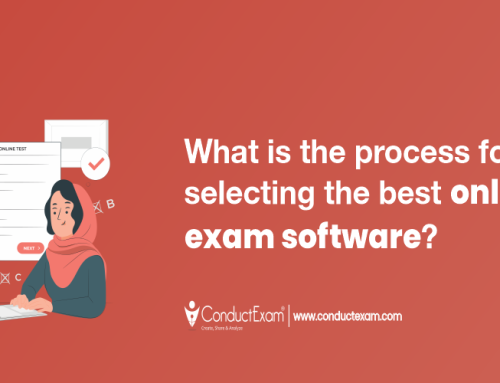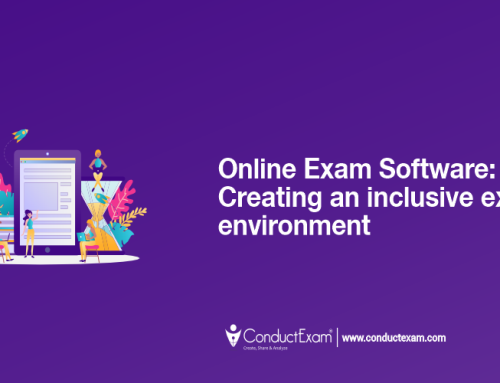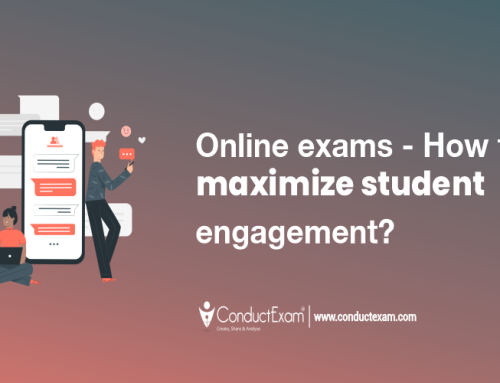Amazingly, the increasing use of the internet expands lots of new great opportunities in several fields. Internet usage, including in the educational sector, helps teachers in gaining student attention. They also use online exams software to arrange the exams.
Few students cheat on tests to achieve high scores. As a result, other students were unable to receive a fair result. Students can cheat when taking both offline and online tests.
Examiners can keep an eye on the students during the traditional exam and prevent them from cheating. However, if the educational institute organizes a virtual test, the risks of cheating are likely to be significant.
Students in the modern era are extremely intelligent and tech-savvy, and as a result, they have discovered ways to cheat. As a result, software developers are integrating proctoring tools. Examiners can use these features to identify students who are attempting to avoid cheating during the examination.
Proctoring through an examiner can detect unauthorized persons. They can also scan the exam takers to obtain a sense of whether or if other people can help the exam takers.
In today’s examination software, there are several new modernized and cutting-edge features available. They will be able to completely avoid cheating in the exam if they use this method. Face recognition, two-factor authentication, location tracking, etc.
These characteristics help the educational institute in creating a cheating-free atmosphere for virtual tests. This proctoring option is both affordable and simple to utilize.
New age online proctoring features
There are a few new-age online proctoring elements that help to protect the online examination process.
1. Two-way authentication
Two-factor authentication is a new method of securing the online exam system. Students can take the exam using conventional methods with single-way verification. Students must, however, prove their identity in two steps while using two-way authentication.
Students must first enter their password and user id. Students must also submit the OTP, fingerprints, and face recognition while using the two-way authentication features. Candidates will be invited to participate in the test if they can successfully submit both current details.
These elements assist the educational institution in preventing unauthorized people from accessing the online tests.
2. Real-time audio & video recording
In the virtual test process, modern remote proctoring options such as real-time audio and video recording are used. Examiners can monitor the exam procedure in real-time with audio and video due to these features. These features can also be used to save the video recording.
The examiner can monitor the suspicious activities by adopting audio and video recording. As a result, this approach helps the educational institute in administering a fair and cheating-free test.
3. Facial recognition
Facial recognition is a more advanced technique that is also very safe. Students can change their login and password easily in today’s technology age. As a result, they can alter the virtual test to their benefit.
That is why software developers can develop facial recognition technology by fixing all the loopholes in the software. Exam takers must scan their faces while using this technology. And they have no control over their looks or the fact that another person is unable to attend an exam.
The suspect students are not attending the exam if any other people are scanned using facial recognition. So, if you use online examination software to administer an online test, you can prevent cheating.
4. Track the location
Exam takers have been known to log in using a different photo or location on multiple occasions. However, some of them are unable to take the exam. They do, however, steal the validated candidates’ passwords and usernames. As a result, the examiner requires a solution to prevent another login from a different IP address.
The examiner can track the IP address or location from where the eligible candidate attended the exam using the tracking features. Examiners can use these features to deduce unauthorized logins from non-recorded IP address systems. In addition, this suspect can access the exam from an unauthorized location. As a result, the distance test examiner will be able to detect and report suspicious users from logging in.
5. Monitoring with the dual camera
Candidates have been caught cheating on multiple occasions with the help of someone hiding behind the camera. The examiner can supervise with the front-end camera in conventional technologizing. They can also bring an end to an unusual behavior if they find anything.
But what if these candidates can cheat from behind the scenes? Examiners can now use the dual camera to observe the test operations as a solution. As a result, educational institutions can complete exam processes properly and successfully by utilizing dual-camera proctoring features.
6. Restriction
Education needs a secure environment while organizing an online exam. Which enables them to easily and fairly report the exam results.
Several unauthorized users attempted to log in during the virtual test. Occasionally, candidates who have been banned from taking the exam attempt to log in. The examiner places limits on some user ids at that time. As a result, they will be unable to participate in the tests.
7. Audio Proctoring Features
The supervisor can detect the background voice using audio proctoring features. This voice, which comes from the candidates, can hear all of the current responses. If an exam taker mutes the audio by accident or on purpose, they will be logged out of the exam. Finally, they are unable to complete the exam due to the muted audio. As a result, students receive a fair grade, and supervisors can use the proctoring features to avoid cheating.
8. Random Test
The supervisor can avoid cheating by using proctoring. How? – Throughout the section, each student attempts the same question in a different sequence. For example, imagine there are ten questions on a test, and one student attempts the first question at a time, while another student attempts the third question as a first question. All of this occurs as a result of the random test proctoring features. As a result, students do not copy each other’s answers while interacting during the exam.
Benefits of using online proctoring features in online exams
The proctoring features of online exam software provide several advantages.
-
To ensure a successful exam, the supervisor can easily monitor student behavior and prevent cheating.
-
Allow the supervisors to keep track of multiple exams at once. They can simply monitor the test process thanks to modern technologies.
-
Teachers or professors can also provide fair results to prevent unauthorized users from logging into the virtual test.
-
Even for the supervisor, remote access is possible. As a result, the test procedure can be monitored remotely by campus supervisors.
-
These features are available in all browsers. As a result, this software is easy to use, even on mobile devices.
These benefits will help the educational institution in preventing cheating and creating a cheating-free environment.
Conclusion
The purpose of the testing is to assess the students and provide appropriate feedback. Candidates are located far from the exam campus when the online exams are arranged. As a result, Supervisors require secure exam software. They can easily set up a cheating-free virtual test using this method. As a result, while distance learning students can get an error-free result by implementing new age proctoring features into examination software, they can get an error-free result.
Contact Us and Book a Free Demo of our Examination software.






Leave A Comment